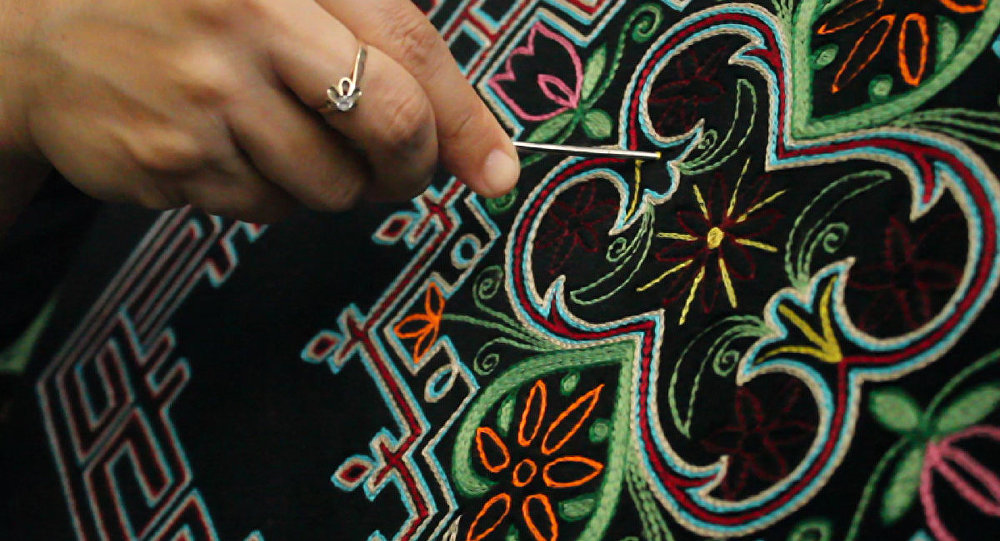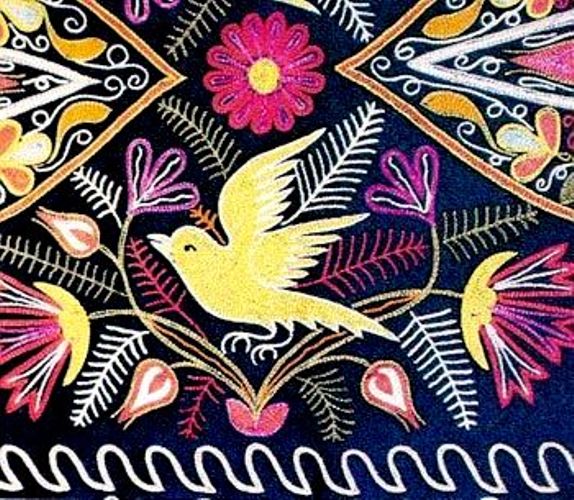
Azerbaijan created a rich and specific culture through the history of the Azerbaijani people. The decorative art was one of the most developed spheres of the culture in Azerbaijan. This art established in ancient times. It embraces different kinds of art including tattooing and jewellery, metal works, ornaments on wood, stones and bones, carpentry, weaving and ornamental knitting and weaving, knitting and other thread-works. All the types of the of this art reflecting the talent and moral world of the Azerbaijani people are widely used in the usual life of people.
The technique and composition of the thread-work of Azerbaijan date back to the remote past and proves the inheritance of the people. It is possible to define the time of the spread of different types of embroidery on the basis of different archaeological materials. The analogues of embroidery ornaments that are the right lines and polylines, zigzags, dotty ornaments, circles, triangles, rhombuses date back to the bronze era (3rd millennium B.C.).
A number of merchants, travellers and diplomats who visited these places in different periods of time provided interesting information about the development of Azeri art. Italian traveller Marko Polo stressed the beauty of the silk wares of Shemakha and Barda in the 13th century. English traveller -merchant Antoni Djenkinson wrote depicting the magnificence of the summer residence (the 16th century): "the king was sitting in the rich tent worked with silk and golden thread; his clothes were all in pearls and precious stones".
Darai and velvet were the most important local materials for the embroidery in the 19th-20th centuries. They were produced in Shemakha, Basgal, Sheki, Ganja, Shusha and other regions of Azerbaijan. The local silk and woollen threads and other patters were used in the embroidery. The plant dye-stuffs were used in dying.
The embroidery wares were distinguished for the richness and diversity of the ornamental motives. The plant motives as the image of roses, daffodils, pinks, tulips, lily, the leaves of the pomegranates, quince and cherry-plum trees as well as ears and leaves of different forms were the widest themes in the embroidery of Azerbaijan.
The geometric ornaments of the embroideries comprised the right and polylines, zigzags, triangles, quadrangles, six and eight-pointed stars, rhombuses and images of the Sun and stars.
The people liked to embroider the nightingales, peacock, hoopoe, sparrow, pheasant, quail and others.
The widely spread image of two birds is the most favourite and ancient theme of decorative art. The birds are usually depicted either in love with each other or offended to each other. Both themes are reflected as love and parting. Among animals, the embroideries mainly contained the images of deer, tortoises, dragons and snakes, horses and others.
The most widely spread of the housing objects were the rails, containers for combs, boxes for cosmetics, jugs and others.
The most popular and widely spread types of embroidery were as follows: gold thread, plain embroidery, chain-stitch, embroidery with the technique "the birds-eye", metal pearls embroidery, pearl embroidery, stamping, "buttoning", flapping, spiral embroidery and work on the file.
The embroidery with golden and silver threads is the most ancient of all the types of embroidery. It mainly used thick cloths. Red, dark red, violet and green one colour velvet was considered the best material. Golden and silver threads produced at the factories were used in embroidery. This type of embroidery was called gold and silver thread.
The gold and silver thread was used in the decoration of the women's clothes, headwear, housing objects, saddles and other small objects. It was also a tradition to include the embroidery wares in a bride's dowry.
Chain-stitch was the most widely spread among the embroidery wares worked with colour threads.
Sheki was the centre of the chain-stitch in the 19th century.
Red, black and dark blue velvet and cloths of local or foreign production were mainly used for the chain-stitch. Not only women were engaged in this type of decorative art. A number of men also demonstrated their talent in this sphere. A master would first draw the contours of the picture on the cloth stretched by the loom and then filled its inner part. The needle used in chain-stitch was called qarmach.
The chain-stitch was used for decoration of the women's clothes, pillow-cases, mutakka, carpets used in the bathrooms.
Plain embroidery was another widely used technique of needle-works.
 This type of embroidery mainly used not bright, pastel colours mainly coloured silk and woollen threads in combination with golden ones. It had two types: two-sided and one-sided. Plain embroidery was used in the decoration of clothes, wall ornaments, curtains and others.
This type of embroidery mainly used not bright, pastel colours mainly coloured silk and woollen threads in combination with golden ones. It had two types: two-sided and one-sided. Plain embroidery was used in the decoration of clothes, wall ornaments, curtains and others.
"The bird's eye" -ornaments worked with white or coloured silk threads was one of the most widely spread types of embroidery.
Buttoning is found in the night headwear (shabkulag), janamaz and woollen clothes. Its simple and water sewing are carried out through laying the thin woollen or cotton layer between the prime and face of the ware.
The embroidery wares worked with pearls excited great interest and they have been in the decoration of costume elements and housing objects.
The embroidery with sparkling ornaments, pearls is the sewing along the contours of the image formed by the colourful silk threads on the cloths. The spiral embroidery is a relatively new type of needle-works.
The less widely spread drawn-thread work established very late and is seldom practised. It is mainly used for decorating of handkerchiefs, veils and napkins.
To date, Azerbaijan preserves the school of the art of embroidery that dates back to ancient times. The wares of this sphere of the art of Azerbaijan are demonstrated at the international exhibitions and in museums.



